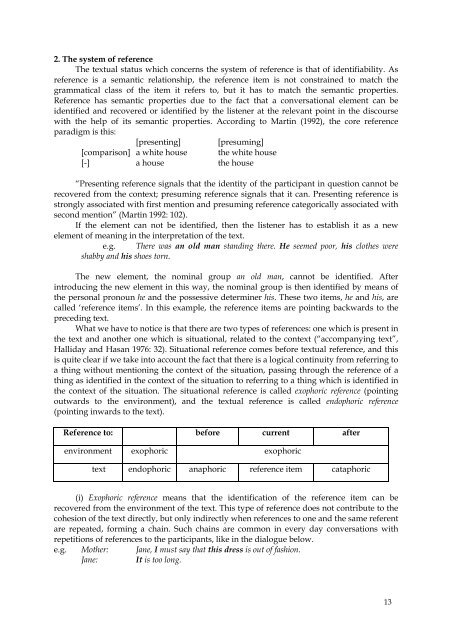Vol. 5/2009 - Facultatea de Litere
Vol. 5/2009 - Facultatea de Litere
Vol. 5/2009 - Facultatea de Litere
Create successful ePaper yourself
Turn your PDF publications into a flip-book with our unique Google optimized e-Paper software.
2. The system of reference<br />
The textual status which concerns the system of reference is that of i<strong>de</strong>ntifiability. As<br />
reference is a semantic relationship, the reference item is not constrained to match the<br />
grammatical class of the item it refers to, but it has to match the semantic properties.<br />
Reference has semantic properties due to the fact that a conversational element can be<br />
i<strong>de</strong>ntified and recovered or i<strong>de</strong>ntified by the listener at the relevant point in the discourse<br />
with the help of its semantic properties. According to Martin (1992), the core reference<br />
paradigm is this:<br />
[presenting] [presuming]<br />
[comparison] a white house the white house<br />
[-] a house the house<br />
“Presenting reference signals that the i<strong>de</strong>ntity of the participant in question cannot be<br />
recovered from the context; presuming reference signals that it can. Presenting reference is<br />
strongly associated with first mention and presuming reference categorically associated with<br />
second mention” (Martin 1992: 102).<br />
If the element can not be i<strong>de</strong>ntified, then the listener has to establish it as a new<br />
element of meaning in the interpretation of the text.<br />
e.g. There was an old man standing there. He seemed poor, his clothes were<br />
shabby and his shoes torn.<br />
The new element, the nominal group an old man, cannot be i<strong>de</strong>ntified. After<br />
introducing the new element in this way, the nominal group is then i<strong>de</strong>ntified by means of<br />
the personal pronoun he and the possessive <strong>de</strong>terminer his. These two items, he and his, are<br />
called ‘reference items’. In this example, the reference items are pointing backwards to the<br />
preceding text.<br />
What we have to notice is that there are two types of references: one which is present in<br />
the text and another one which is situational, related to the context (“accompanying text”,<br />
Halliday and Hasan 1976: 32). Situational reference comes before textual reference, and this<br />
is quite clear if we take into account the fact that there is a logical continuity from referring to<br />
a thing without mentioning the context of the situation, passing through the reference of a<br />
thing as i<strong>de</strong>ntified in the context of the situation to referring to a thing which is i<strong>de</strong>ntified in<br />
the context of the situation. The situational reference is called exophoric reference (pointing<br />
outwards to the environment), and the textual reference is called endophoric reference<br />
(pointing inwards to the text).<br />
Reference to: before current after<br />
environment exophoric exophoric<br />
text endophoric anaphoric reference item cataphoric<br />
(i) Exophoric reference means that the i<strong>de</strong>ntification of the reference item can be<br />
recovered from the environment of the text. This type of reference does not contribute to the<br />
cohesion of the text directly, but only indirectly when references to one and the same referent<br />
are repeated, forming a chain. Such chains are common in every day conversations with<br />
repetitions of references to the participants, like in the dialogue below.<br />
e.g. Mother: Jane, I must say that this dress is out of fashion.<br />
Jane: It is too long.<br />
13












